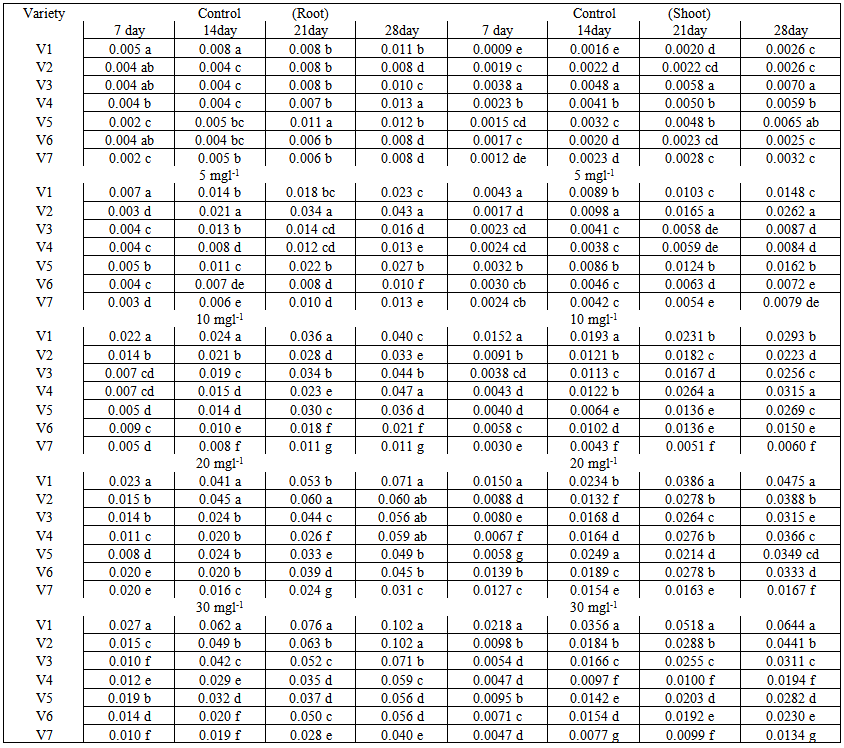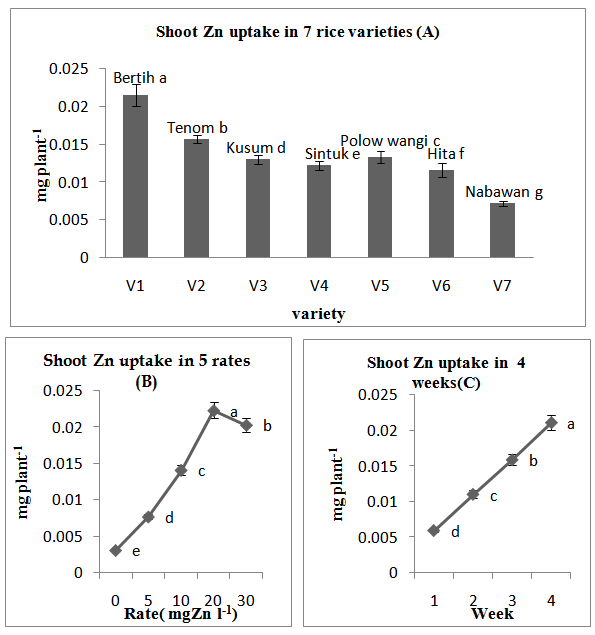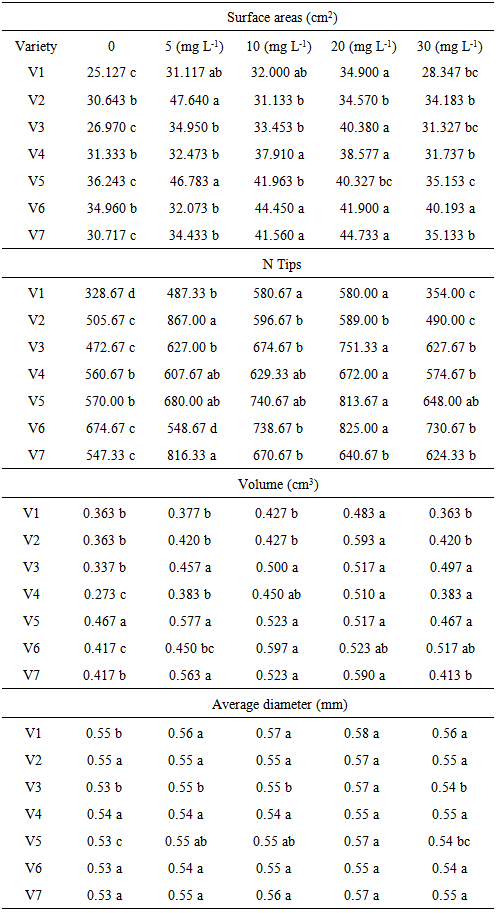-
Paper Information
- Previous Paper
- Paper Submission
-
Journal Information
- About This Journal
- Editorial Board
- Current Issue
- Archive
- Author Guidelines
- Contact Us
International Journal of Agriculture and Forestry
p-ISSN: 2165-882X e-ISSN: 2165-8846
2014; 4(3): 255-260
doi:10.5923/j.ijaf.20140403.18
Effect of Different Rates of Zinc on Root Morphological Traits among Different Upland Rice Landraces in Malaysia
G. Sharifianpour1, A. R. Zaharah1, C. F. Ishak1, M. M. Hanafi1, B. Khayyambashi1, A. Sharifkhani2
1Land Management Department, Faculty of Agriculture, University Putra Malaysia
2Institute Tropical Agriculture, Faculty of Agriculture, University Putra Malaysia
Correspondence to: G. Sharifianpour, Land Management Department, Faculty of Agriculture, University Putra Malaysia.
| Email: |  |
Copyright © 2014 Scientific & Academic Publishing. All Rights Reserved.
Billions of people globally are estimated to suffer from Zn deficiency due to their low dietary intake, especially those with rice. Global efforts are under way to improve the Zn concentrations in rice to increase Zn in diets. Zinc uptake in relation to morphological root parameters among 7 upland rice varieties were studied by conducting a solution culture experiment using modified Yoshida solution in Agriculture Faculty of University Putra Malaysia. Five Zinc levels were developed by the addition of 0, 5, 10, 20, 30 mg L-1 ZnSO4. Seedlings were harvested in week 4. Zn uptake in roots and shoots of upland rice showed significant differences among all varieties. Root Zn uptake significantly increased at all rates. Other root parameters (length, average diameter, surface area, volume, and number of root tips) did not show any significant differences in 0 to 20 mg Zn L-1, but they decreased significantly in 30 mg Zn L-1 in 4th week of observation. In addition shoot Zn uptake like other root parameters followed this trend and decreased significantly in 30 mg Zn L-1 in 4th week of observation.
Keywords: Zinc, Rice, Root morphology, Zn Uptake, Upland Rice
Cite this paper: G. Sharifianpour, A. R. Zaharah, C. F. Ishak, M. M. Hanafi, B. Khayyambashi, A. Sharifkhani, Effect of Different Rates of Zinc on Root Morphological Traits among Different Upland Rice Landraces in Malaysia, International Journal of Agriculture and Forestry, Vol. 4 No. 3, 2014, pp. 255-260. doi: 10.5923/j.ijaf.20140403.18.
1. Introduction
- Zinc (Zn) is an essential micronutrient for normal growth and development of plants (Broadley, et al., 2007). The normal concentration of this element is 25 to 150 mg kg-1 in plants. Deficiencies of Zn are usually associated with concentrations of less than 20 mg kg-1, and toxicities will occur when the Zn leaf concentration exceeds 400 mg L-1 (Dobermann and Fairhurst, 2000). Cultivars differ in their ability to take up Zn, which may be caused by differences in Zinc translocation and utilization, differential accumulation of nutrients that interact with Zn and differences in plant roots to exploit for soil Zn (Tisdale, et al., 1993). Earlier studies have shown that Zinc mass concentration (ZnMC) in all plant organs increased with an increase in Zn supply but to various degrees. At higher uptake levels, the ZnMC in stems increased most, while the ZnMC in hulled grains (brown rice) increased least (Jiang, et al., 2008).Rice, the main staple food of Asia, is inherently very low in Zn and its high consumption relative to other foods contributes to high incidence of Zn deficiency in human populations in Asia (Gibson, et al., 2007; Stein, et al., 2007). Upland rice is water saving rice production system depending on irrigation water management and anticipated yield (Wang, et al., 2009). Upland rice needs to have a deeper rooting and a higher root length and density than lowland rice cultivars because of the limited water availability under aerobic as compared to flooded conditions (Matsuo, et al., 2010). The primary source of Zn for rice plants is trough root uptake (Welch and Graham, 2002), To increase Zn uptake by roots, the Zn availability in the rhizosphere must be increased (Welch and Shuman, 1995). Some researchers reported that under nutrient-deficient conditions, plants tend to alter their root size and morphology for efficient nutrient acquisition. Enhanced root growth under Zn deficiency, both in length and number of roots, has been associated with Zn-deficiency tolerance of lowland rice genotypes. (Chen, et al., 2009). In addition researchers showed Under moderate Zn deficiency, damage to root tip cells was observed in some susceptible genotypes (Widodo, et al., 2010). Most recent studies in rice suggest that among numerous other mechanisms, Zn uptake is most important. However, the root traits in upland rice are not well understood. This study was undertaken to evaluate the effect of different rates of Zinc on root morphological traits among different upland rice landraces in Malaysia.
2. Materials and Methods
- Seven upland varieties (Table 1) were collected from different parts of Malaysia. This study was conducted at Faculty of Agriculture, University Putra Malaysia from April to May 2012.
 | Table 1. Name of varieties |
3. Result and Discussion
- Effects of different rates of Zinc on Zinc uptake in roots showed V1 in control treatment was shown the highest Zn uptake in roots (0.005 mg plant-1) Then, V5 and V7 were shown the lowest Zn uptake in root (0.002 mg plant-1) (Table 2). The highest Zn uptake in root was recorded in V1and V2 at 30 (mg L-1) at week 4, (0.102 mg plant-1) and the lowest was recorded in V7 (0.04 mg plant-1) as indicated in table 2.
 | Table 2. Means comparison of root and shoot Zn uptake of seven rice varieties in five rates at four weeks(Means in a column with the same letters are not significantly different at 5% level) |
 | Figure 1. Means comparison of root Zn uptake of (A) seven rice varieties (B) five rates (C) four weeks |
 | Figure 2. Means comparison of shoot Zn uptake of (A) seven rice varieties (B) five rates (C) four weeks |
|
4. Conclusions
- Increase of Zinc rate has a positive effect on morphological root parameters up to 20 mg L-1. Soluble forms of Zn are readily available to plants and the uptake of Zn has been reported to be linear with concentration in the nutrient solution and soils. In addition, plants grown in Zn-contaminated soils accumulate a great proportion of the metal in the roots (Kabata-Pendias, 2000). This shows that Zn in high concentration causes root growth disorder. Results of this study showed at 30 mgZn L-1 young plants died, possibly due to toxic effect of Zn. Sensitive plant species are reported to be retarded in growth when their tissues contain 20 to 200 mgZn kg-1. However, the upper toxic levels range in various plants are from 100 to 500 mgZn kg-1 (DW) (Kabata-Pendias, 2000).
References
| [1] | Alam, S., Ali, M., and Islam, E. (2002). Effects of zinc, nitrogen and temperatures on seedling growth of rice. Pakistan Journal of Botany, 34(4), 351-354. |
| [2] | Broadley, M. R., White, P. J., Hammond, J. P., Zelko, I., and Lux, A. (2007). Zinc in plants. New Phytologist, 173(4), 677-702. |
| [3] | Chen, W., He, Z., Yang, X., and Feng, Y. (2009). Zinc efficiency is correlated with root morphology, ultrastructure, and antioxidative enzymes in rice. Journal of Plant Nutrition, 32(2), 287-305. |
| [4] | Dobermann, A., and Fairhurst, T. (2000). Rice: Nutrient disorders and nutrient management: Int. Rice Res. Inst. |
| [5] | Ebbs, S. D., and Kochian, L. V. (1998). Phytoextraction of zinc by oat (Avena sativa), barley (Hordeum vulgare), and Indian mustard (Brassica juncea). Environmental science & technology, 32(6), 802-806. |
| [6] | Gao, X., Hoffland, E., Stomph, T., Grant, C. A., Zou, C., and Zhang, F. (2011). Improving zinc bioavailability in transition from flooded to aerobic rice. A review. Agronomy for sustainable development, 32(2), 465-478. |
| [7] | Genc, Y., Huang, C. Y., and Langridge, P. (2007). A study of the role of root morphological traits in growth of barley in zinc-deficient soil. Journal of Experimental Botany, 58(11), 2775-2784. |
| [8] | Gibson, R. S., Manger, M. S., Krittaphol, W., Pongcharoen, T., Gowachirapant, S., Bailey, K. B., et al. (2007). Does zinc deficiency play a role in stunting among primary school children in NE Thailand? British Journal of Nutrition, 97(01), 167-175. |
| [9] | Jiang, W., Struik, P., Van Keulen, H., Zhao, M., Jin, L., and Stomph, T. (2008). Does increased zinc uptake enhance grain zinc mass concentration in rice? Annals of Applied Biology, 153(1), 135-147. |
| [10] | Kabata-Pendias, A. (2000). Trace elements in soils and plants: CRC press. |
| [11] | Matsuo, N., Ozawa, K., and Mochizuki, T. (2010). Physiological and morphological traits related to water use by three rice (Oryza sativa L.) genotypes grown under aerobic rice systems. Plant and Soil, 335(1), 349-361. |
| [12] | Song, A., Li, P., Li, Z., Fan, F., Nikolic, M., and Liang, Y. (2011). The alleviation of zinc toxicity by silicon is related to zinc transport and antioxidative reactions in rice. Plant and Soil, 344(1-2), 319-333. |
| [13] | Stein, A. J., Nestel, P., Meenakshi, J., Qaim, M., Sachdev, H., and Bhutta, Z. A. (2007). Plant breeding to control zinc deficiency in India: How cost-effective is biofortification? Public health nutrition, 10(05), 492-501. |
| [14] | Tisdale, S. L., Nelson, W. L., and Beaton, J. L. (1993). Soil fertility and fertilizers. New Jersey USA: Pearson Education. |
| [15] | Wang, R., Chen, C., Yang, X., and Zhang, Y. (2009). Growth responses to varying zinc activities in rice genotypes differing in Zn efficiency and Zn density. Journal of Plant Nutrition, 32(4), 681-693. |
| [16] | Welch, R. M., and Graham, R. D. (2002). Breeding crops for enhanced micronutrient content. Plant and Soil, 245(1), 205-214. |
| [17] | Welch, R. M., and Shuman, L. (1995). Micronutrient nutrition of plants. Critical Reviews in plant sciences, 14(1), 49-82. |
| [18] | Widodo, B., Rose, T., and Frei, M. (2010). Response to zinc deficiency of two rice lines with contrasting tolerance is determined by root growth maintenance and organic acid exudation rates, and not by zinc-transporter activity. New Phytologist 186, 400-401. |
| [19] | Yoshida, S. (1981). Fundamentals of rice crop science: Int. Rice Res. Inst. |
 Abstract
Abstract Reference
Reference Full-Text PDF
Full-Text PDF Full-text HTML
Full-text HTML
